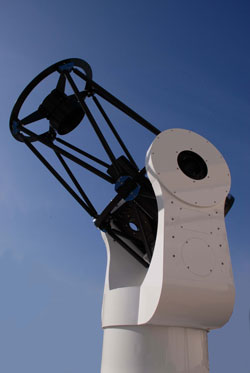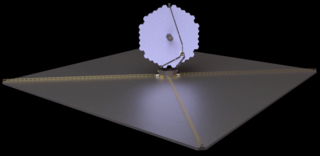Related Research Articles

The Very Large Telescope (VLT) is a facility operated by the European Southern Observatory, located on Cerro Paranal in the Atacama Desert of northern Chile. It consists of four individual telescopes, each equipped with a primary mirror that measures 8.2 meters in diameter. These optical telescopes, named Antu, Kueyen, Melipal, and Yepun, are generally used separately but can be combined to achieve a very high angular resolution. The VLT array is also complemented by four movable Auxiliary Telescopes (ATs) with 1.8-meter apertures.

The Large Binocular Telescope (LBT) is an optical telescope for astronomy located on 10,700-foot (3,300 m) Mount Graham, in the Pinaleno Mountains of southeastern Arizona, United States. It is a part of the Mount Graham International Observatory.

A Ritchey–Chrétien telescope is a specialized variant of the Cassegrain telescope that has a hyperbolic primary mirror and a hyperbolic secondary mirror designed to eliminate off-axis optical errors (coma). The RCT has a wider field of view free of optical errors compared to a more traditional reflecting telescope configuration. Since the mid 20th century, a majority of large professional research telescopes have been Ritchey–Chrétien configurations; some well-known examples are the Hubble Space Telescope, the Keck telescopes and the ESO Very Large Telescope.

Adaptive optics (AO) is a technique of precisely deforming a mirror in order to compensate for light distortion. It is used in astronomical telescopes and laser communication systems to remove the effects of atmospheric distortion, in microscopy, optical fabrication and in retinal imaging systems to reduce optical aberrations. Adaptive optics works by measuring the distortions in a wavefront and compensating for them with a device that corrects those errors such as a deformable mirror or a liquid crystal array.

Angular resolution describes the ability of any image-forming device such as an optical or radio telescope, a microscope, a camera, or an eye, to distinguish small details of an object, thereby making it a major determinant of image resolution. It is used in optics applied to light waves, in antenna theory applied to radio waves, and in acoustics applied to sound waves. The colloquial use of the term "resolution" sometimes causes confusion; when an optical system is said to have a high resolution or high angular resolution, it means that the perceived distance, or actual angular distance, between resolved neighboring objects is small. The value that quantifies this property, θ, which is given by the Rayleigh criterion, is low for a system with a high resolution. The closely related term spatial resolution refers to the precision of a measurement with respect to space, which is directly connected to angular resolution in imaging instruments. The Rayleigh criterion shows that the minimum angular spread that can be resolved by an image forming system is limited by diffraction to the ratio of the wavelength of the waves to the aperture width. For this reason, high resolution imaging systems such as astronomical telescopes, long distance telephoto camera lenses and radio telescopes have large apertures.

An optical telescope is a telescope that gathers and focuses light mainly from the visible part of the electromagnetic spectrum, to create a magnified image for direct visual inspection, to make a photograph, or to collect data through electronic image sensors.

In astronomy, seeing is the degradation of the image of an astronomical object due to turbulence in the atmosphere of Earth that may become visible as blurring, twinkling or variable distortion. The origin of this effect is rapidly changing variations of the optical refractive index along the light path from the object to the detector. Seeing is a major limitation to the angular resolution in astronomical observations with telescopes that would otherwise be limited through diffraction by the size of the telescope aperture. Today, many large scientific ground-based optical telescopes include adaptive optics to overcome seeing.

The Giant Magellan Telescope is a 25.4-meter, ground-based, extremely large telescope under construction at Las Campanas Observatory in Chile's Atacama Desert. Commissioning is anticipated in the late 2020s. Once complete, the Giant Magellan will be the largest Gregorian telescope ever built observing in optical and mid-infrared light. The telescope uses seven of the world’s largest mirrors to form a light collecting area of 368 square meters.

A segmented mirror is an array of smaller mirrors designed to act as segments of a single large curved mirror. The segments can be either spherical or asymmetric. They are used as objectives for large reflecting telescopes. To function, all the mirror segments have to be polished to a precise shape and actively aligned by a computer-controlled active optics system using actuators built into the mirror support cell.

A telescope is a device used to observe distant objects by their emission, absorption, or reflection of electromagnetic radiation. Originally it was an optical instrument using lenses, curved mirrors, or a combination of both to observe distant objects – an optical telescope. Nowadays, the word "telescope" is defined as wide range of instruments capable of detecting different regions of the electromagnetic spectrum, and in some cases other types of detectors.

The Daniel K. Inouye Solar Telescope (DKIST) is a scientific facility for studies of the Sun at Haleakala Observatory on the Hawaiian island of Maui. Known as the Advanced Technology Solar Telescope (ATST) until 2013, it was named after Daniel K. Inouye, a US Senator for Hawaii. It is the world's largest solar telescope, with a 4-meter aperture. The DKIST is funded by National Science Foundation and managed by the National Solar Observatory. The total project cost is $344.13 million. It is a collaboration of numerous research institutions. Some test images were released in January 2020. The end of construction and transition into scientific observations was announced in November 2021.
Daniel Apai is a professor and astrophysicist at The University of Arizona in Tucson, Arizona. He is known for his studies of astrobiology, extrasolar planets, and the formation of planetary systems. He is the principal investigator of the Earths in Other Solar Systems team of NASA's Nexus for Exoplanet System Studies and the Hubble Space Telescope Cloud Atlas Treasury program, and Project EDEN, a large survey for habitable planets in the immediate solar neighborhood. He is leading the Nautilus Space Observatory space telescope concept and co-leading the technology development underpinning it.

The MINiature Exoplanet Radial Velocity Array (MINERVA) is a ground-based robotic dedicated exoplanet observatory. The facility is an array of small-aperture robotic telescopes outfitted for both photometry and high-resolution Doppler spectroscopy located at the U.S. Fred Lawrence Whipple Observatory at Mt. Hopkins, Arizona. The project's principal investigator is the American astronomer Jason Eastman. The telescopes were manufactured by PlaneWave Instruments.

The Simons Observatory is located in the high Atacama Desert in Northern Chile inside the Chajnator Science Preserve, at an altitude of 5,200 meters (17,000 ft). The Atacama Cosmology Telescope (ACT) and the Simons Array are located nearby and these experiments are currently making observations of the Cosmic Microwave Background (CMB). Their goals are to study how the universe began, what it is made of, and how it evolved to its current state. The Simons Observatory shares many of the same goals but aims to take advantage of advances in technology to make far more precise and diverse measurements. In addition, it is envisaged that many aspects of the Simons Observatory will be pathfinders for the future CMB-S4 array.

The Large Ultraviolet Optical Infrared Surveyor, commonly known as LUVOIR, is a multi-wavelength space telescope concept being developed by NASA under the leadership of a Science and Technology Definition Team. It is one of four large astrophysics space mission concepts studied in preparation for the National Academy of Sciences 2020 Astronomy and Astrophysics Decadal Survey.

The Habitable Exoplanet Observatory (HabEx) is a space telescope concept that would be optimized to search for and image Earth-size habitable exoplanets in the habitable zones of their stars, where liquid water can exist. HabEx would aim to understand how common terrestrial worlds beyond the Solar System may be and determine the range of their characteristics. It would be an optical, UV and infrared telescope that would also use spectrographs to study planetary atmospheres and eclipse starlight with either an internal coronagraph or an external starshade.

Origins Space Telescope (Origins) is a concept study for a far-infrared survey space telescope mission. A preliminary concept in pre-formulation, it was presented to the United States Decadal Survey in 2019 for a possible selection to NASA's large strategic science missions. Origins would provide an array of new tools for studying star formation and the energetics and physical state of the interstellar medium within the Milky Way using infrared radiation and new spectroscopic capabilities.

Yerkes 41-inch reflector is a 40-inch aperture (101.6 cm) reflecting telescope at the Yerkes Observatory, that was completed in 1968. It is known as the 41 inch to avoid confusion with a 40 inch refractor at the observatory. Optically it is a Ritchey–Chrétien design, and the main mirror uses low expansion glass. The telescope was used as a testbed for an adaptive optics system in the 1990s.
References
- 1 2 3 4 5 6 Nautilus A Very Large-Aperture, Ultralight Space Telescope for Exoplanet Exploration, Time-domain Astrophysics, and Faint Objects. A white paper. D'aniel Apai, Steward Observatory and Lunar and Planetary Laboratory. The University of Arizona. 2019.
- 1 2 3 4 5 6 University of Arizona (2 August 2019). "A new lens for life-searching space telescopes". EurekAlert! . Retrieved 5 August 2019.
- ↑ Apai, Dániel; Milster, Tom D.; Kim, Dae Wook; Bixel, Alex; Schneider, Glenn; Liang, Ronguang; Arenberg, Jonathan (29 July 2019). "A Thousand Earths: A Very Large Aperture, Ultralight Space Telescope Array for Atmospheric Biosignature Surveys". The Astronomical Journal . 158 (2): 83. arXiv: 1906.05079 . Bibcode:2019AJ....158...83A. doi: 10.3847/1538-3881/ab2631 . hdl: 10150/634070 . S2CID 186206769.
- ↑ Apai, D.; et al. (2018). "Nautilus DeepSpace Observatory: A Giant Segmented Space Telescope Array for a Galactic Biosignature Survey" (PDF). Universities Space Research Association . Retrieved 5 August 2019.
- ↑ Apai, D.; et al. (1 February 2018). "Nautilus Deep Space Observatory: A Giant Segmented Space Telescope Array for a Galactic Biosignature Survey". Harvard University . 2063: 3127. Bibcode:2018LPICo2063.3127A.
- 1 2 3 4 Wallace, John (5 August 2019). "Multi-order diffractive optical elements could lead to extremely light space telescopes - University of Arizona Project Nautilus aims to create a space telescope that can survey transiting exo-earths for biosignatures 1000 light years away". Laser Focus World . Retrieved 6 August 2019.
- 1 2 3 4 A Different Kind of Eye on the Cosmos. Stewart Willis, Optics & Photonics. 9 August 2019.
- ↑ Staff (2019). "Nautilu: A Revolutionary Space Telescope - A very large aperture, ultralight space telescope for exoplanet exploration, time-domain astrophysics, and faint objects". Nautilus-Array.space. Retrieved 6 August 2019.

